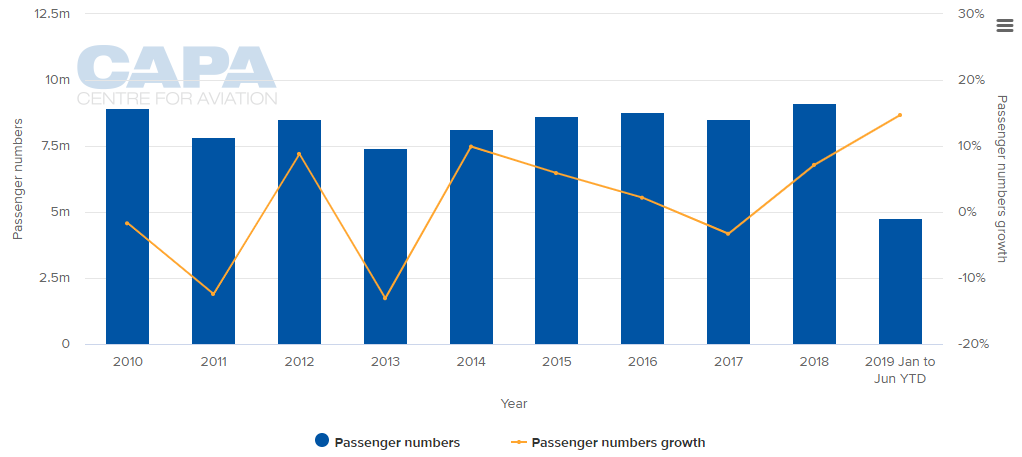By 'New Bahrain Airport' he is actually only referring to the new terminal at the existing Bahrain International gateway which has been under construction since 2016 and which is part of a USD1.1 billion package that also includes a hotel, a private jet terminal and leisure facilities.
That terminal was supposed to be open at first in 2Q2019, then 3Q2019 and the anticipated opening date now lies on or before Mar-2020. Operational readiness trials (ORAT) have already taken place but the delay was brought about when MPs insisted it was not ready.
So what is the rationale for an entirely new airport in the future? The existing one, home to the now largely overlooked (outside the Middle East) Gulf Air, which has two-thirds of the capacity, has exceeded its overall capacity with in excess of nine million passengers in 2018 (+7.1%) and +14.7% growth in 1H2019.
CHART - Bahrain International airport has seen annual traffic levels rise modestly over the 2010s, albeit with significant annual variations Source: CAPA - Centre for Aviation and Bahrain's Ministry of Transportation and Telecommunications (MTT)
Source: CAPA - Centre for Aviation and Bahrain's Ministry of Transportation and Telecommunications (MTT)
With the new terminal alone, four times the size of the existing one, it would be able to handle 14 million ppa, but the long-term projection is for traffic to rise to 27 million ppa by 2040. If an airport is old (and Bahrain Airport was established in 1927, making it the oldest in the Gulf), a case can be made for an entirely new one if sustainable projections can be made about demand in the future.
But care must be exercised. There has been rapid expansion of airports elsewhere in the region based on projections that were not sustainable. Dubai World Central for example, while a significant cargo facility with an attendant 'airport city', has not attracted anywhere like the passenger traffic that was anticipated.
One benefit of a new airport would be the potential to attract new carriers and expand the route network as often happens in these cases. Bahrain's route map (see below) is quite limited compared to those of some of its competing peers in Qatar, United Arab Emirates and even Saudi Arabia It has only a handful of European services (mainly to the 'FLAP' airports - Frankfurt, London Heathrow, Amsterdam and Paris CDG), a few to Africa and none of them sub-Saharan, few to Asia and none at all to the Americas or Oceania.
CHART - Bahrain International airport is ranked just outside of the world's top 200 by system seats, with approaching 30 airlines currently offering flights to 55 passenger destinations Source: CAPA - Centre for Aviation and OAG (data: w/c 18-Nov-2019)
Source: CAPA - Centre for Aviation and OAG (data: w/c 18-Nov-2019)
One might reasonably argue that just about all the hub/spoke demand in the region has been hoovered up by the MEB3 (Middle East Big 3, of Dubai International, Doha's Hamad International and Abu Dhabi International) while the challenges are coming from Istanbul to the (far) west and Oman to the (near) east.
But Bahrain is an ambitious state, with the first 'post-oil' economy in the Persian Gulf, although 85% of revenues are still derived from oil. Since the late 20th century, Bahrain has been investing in the banking and tourism sectors and many large financial institutions have a presence in Manama, the country's capital. Internationally the country has obtained a far higher tourism profile since it began hosting the Formula 1 Grand Prix, bringing the sporting event to the region in 2004.
CHART - Gulf Air is in the middle of a fleet rollover that will be based around Airbus A320neo Family and Boeing 787 Dreamliner fleets Source: CAPA - Centre for Aviation Fleet Database (data: w/c 18-Nov-2019)
Source: CAPA - Centre for Aviation Fleet Database (data: w/c 18-Nov-2019)
One of Gulf Air's problems has been a small O&D market, but Bahrain continuing to build its tourist offer could boost passenger numbers without it having to go too far down the hubbing road. The airline has selected the Boeing 787-9 as the basis of its long-haul flying and started to renew its single-aisle fleet with some initial Airbus A320neo arrivals - more, plus A321neo versions are on order, including long range variants that are well suited to the development of thinner O&D routes, cost-effectively.
Bahrain Airport Company has been managing and operating the Bahrain International airport since 2008. It falls under the umbrella of the Gulf Air Holding Company, which in turn is owned by Mumtalakat, Bahrain's sovereign wealth fund.